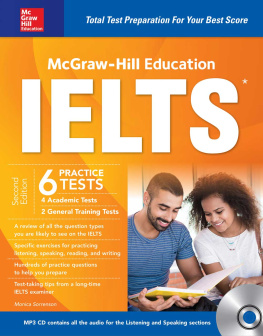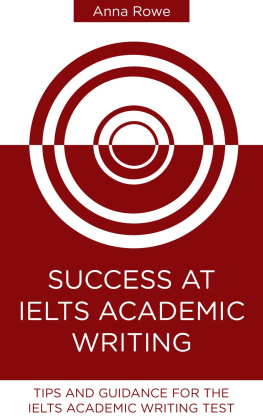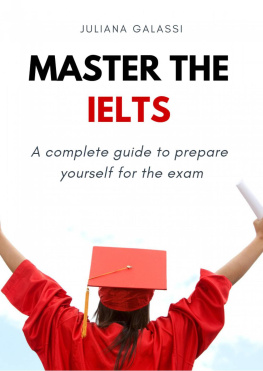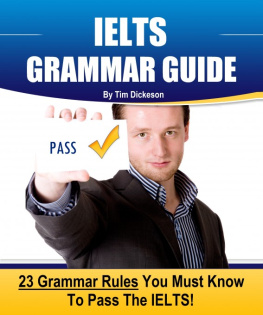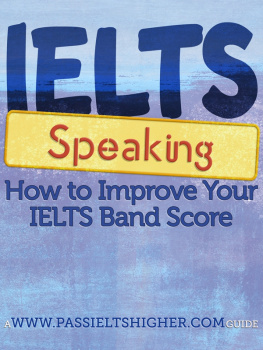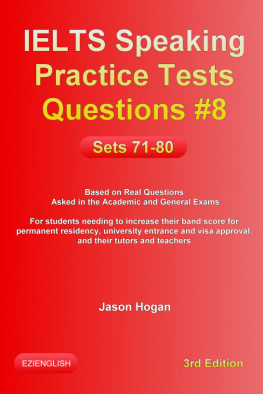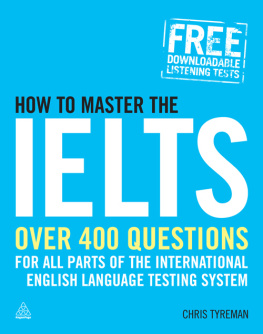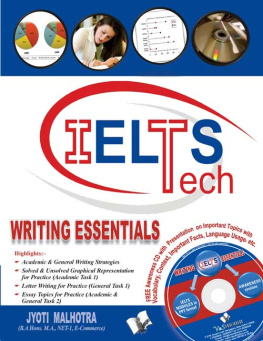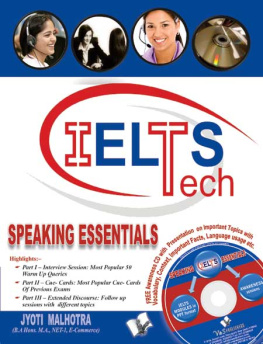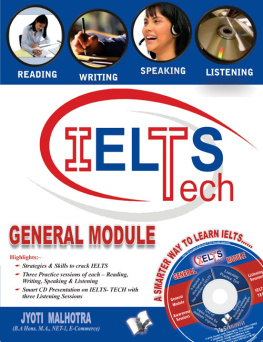Contents
Guide

McGraw-Hill Education
IELTS
Monica Sorrenson has been an IELTS examiner in nine countries and a teacher in fifteen. She has qualifications from Australia and the United Kingdom.
Copyright 2017, 2012 by McGraw-Hill Education. All rights reserved. Printed in the United States of America. Except as permitted under the United States Copyright Act of 1976, no part of this publication may be reproduced or distributed in any form or by any means, or stored in a database or retrieval system, without the prior written permission of the publisher.
1 2 3 4 5 6 7 8 9 LHS 21 20 19 18 17 16
ISBN 978-1-259-85956-4 (book and CD set)
MHID 1-259-85956-8
ISBN 978-1-259-85958-8 (book for set)
MHID 1-259-85958-4
e-ISBN 978-1-259-85957-1
e-MHID 1-259-85957-6
IELTS is a trademark of IELTS Partners, defined as the British Council, IELTS Australia Pty Ltd (solely owned by IDP Education Pty Ltd), and the University of Cambridge: Cambridge English: Language Assessment. These organizations were not involved in the production of, and do not endorse, this product.
McGraw-Hill Education products are available at special quantity discounts to use as premiums and sales promotions, or for use in corporate training programs. To contact a representative, please visit the Contact Us pages at www.mhprofessional.com.
To access the audio files online, go to:
www.MH-IELTSaudio.com
CONTENTS
PART I
Getting Started

CHAPTER Introducing IELTS
What is the IELTS exam?
The International English Language Testing System (IELTS) is the worlds largest exam, and as its name suggests, it is used to test English language for college and university entrance, as well as for immigration or registration with professional bodies.
There are two kinds of IELTS tests: the Academic test for further study and the General Training (GT) test for immigration.
There is no pass or fail with IELTS. Instead, there are bands that show a persons level. These bands range from 0-9. A Zero is a candidate who didnt come for the test; and a Nine is a native speaker someone whose English is perfect. A Five is a person who makes a lot of mistakes but can generally be understood. A Six is still an intermediate speaker, whereas a Seven is starting to get good. An Eight has perhaps only five or six errors in his or her 650 words of writing, and in the Speaking test, makes only very occasional errors. A Six is not that hard to score, but a Seven takes years of intensive study and usually residence in an English-speaking country.
The bands are used by different institutions or authorities. If you want to attend university in many English-speaking countries, you need at least IELTS 5.5 the more famous the university, or the course, the higher the score you need. If you want permanent residence in Canada, you need a Seven. If youre a nurse and you want to continue nursing in Australia, then you also need a Seven overall, including a Seven in Speaking.
IELTS has full and half bands, meaning that a person who gets 6.5 is better than a Six, but not yet a Seven. One thing to note about these scores is that its rather easy to go from a Four to a 4.5, or even a Five to a 5.5, but to progress beyond Six takes much longer. There are also candidates who never reach Six. You cant just take the test, take it again, and again and again, and hope on the fifth attempt youll be handed a 6.5. No. Youve got to fit the description of 6.5 in order to get it.
If youd like to know which nationalities or first languages currently achieve which scores, go to the IELTS website: www.ielts.org . Theres plenty of interesting data there as well as free practice materials.
What are the four parts of the test?
IELTS is made up of four sub-tests. Candidates do all of them on one or two days. They are, in the order that they take place: Listening, Reading, Writing, and Speaking.
The four tests are equally weighted, or if you think of it another way: worth 25% each. A band is given for each one, and there is also an average or Overall Band. A candidate receives a report within two weeks of taking the test with five scores on it like this:
Listening | Reading | Writing | Speaking |
| 6.5 | | 6.5 |
Overall Band = 6.5
You can see that the candidate above was best at Listening and worst at Writing. Reading and Speaking were the same. The majority of candidates receive a report like this. Its very rare for one skill to be much better than another.
But what was the Listening test? What did the candidate need to do for Writing?
Read the table below about the IELTS Academic test to understand exactly what happens. GT is the same as Academic for Listening and Speaking, but a little different for Reading and Writing.
ACADEMIC
Test | How long does the test take? | What is its format? | What question types are there? |
Listening | 40 minutes A recording lasts for 30 minutes. There are 10 extra minutes to transfer answers from a question booklet onto an answer sheet after the recording has finished. | Around 40 questions in four sections. Each section has 10 questions. Each question is worth one mark. Questions are easy at the start and become more difficult as the test progresses. On a test day, all candidates listen to the same recording and have the same questions, but these recordings and questions differ from test to test. There are different versions of all IELTS tests. | The following may be used: Multi-choice (choosing one answer from three possibilities) Multiple matching (choosing more than one answer from a list of up to seven possibilities) Choosing a graphic Note / Table / Sentence / Summary completion (filling in gaps) Labelling maps or plans Providing one- to three-word answers |
Reading | 60 minutes Candidates transfer their answers as they read. There is no extra time. | Around 40 questions in three passages. Passage 1 : (13 or 14 questions) Passage 2 : (13 or 14 questions) Passage 3 : (13 questions) Each question is worth one mark. Questions are easy at the start and become more difficult as the test progresses. Words to be read in the passages: 2500-2750. (With questions, there are around 3500 words.) | The following may be used: Multi-choice (choosing one answer from four possibilities) Multiple matching (choosing more than one answer from a list of up to seven possibilities) Choosing a graphic Note / Table / Sentence / Summary completion (filling in gaps) Labelling maps or plans Providing one- to three-word answers Completing a summary by choosing words that are given in a long list Indicating which paragraph contains information Choosing True / False / Not Given for facts Choosing Yes / No / Not Given for views or opinions Choosing headings Labelling a diagram or a flowchart |
Writing | 60 minutes |

